During the week of June 23-29, 2022, russia continued to commit new acts of nuclear, missile, environmental and food terror and threaten the security of Europe and the world.
In order to bring the aggressor country to justice for the crimes committed, Ukraine secured strong international support and strengthened partnership in the issue of post-war environmental restoration, reports Ministry of Environment.
On June 24, Ukraine and the EU signed an agreement on joining the LIFE program, which will help attract financing for innovative projects in the field of environmental protection and green recovery in the post-war period.
Threats to nuclear and radiation safety
June 26 a russian winged missile flew critically low over the South Ukrainian NPP.
"Russia continues to threaten the security of Ukrainian nuclear power plants and threatens the whole world with a new nuclear disaster. In the case of falling into a working nuclear power unit, even a fragment of a rocket can cause an accident and a radiation leak," the Ministry of the Environment noted.
June 25 during the shelling of Kharkiv, the nuclear subcritical installation "Neutron Source" was damaged. The buildings and infrastructure of the industrial site were damaged. The radiation background is within normal limits, but the continuation of the bombardment may lead to severe radiation consequences with contamination of the surrounding areas.
Zaporizhzhia NPP continues to work in the occupation. Nuclear security continues to be at risk as the russian military prepares for hostilities near Europe's largest nuclear facility. In addition, the occupiers are going to drain the cooling pools of the nuclear power plant in search of weapons, which could lead to a nuclear hazard.
Attacks on infrastructure and industrial facilities
June 23 warehouses in Kharkiv were fired upon, causing a fire. In the village of Pechenygi, Chuguyiv district, Kharkiv region, a fire broke out at an agricultural enterprise after shelling.
June 24 managed to eliminate a large-scale fire at a gas processing enterprise in the Izyum district of the Kharkiv region, which arose as a result of a Russian attack on June 18.
June 25-26 massive missile strikes (60-80 missiles) caused numerous casualties and destruction in Zhytomyr, Chernihiv, Lviv, Mykolaiv, Khmelnytskyi, Rivne and Kyiv regions.
June 25 attacked enterprises in the Mykolaiv region and destroyed the parking lot of agricultural machinery and the base of fuel and lubricants of the agricultural enterprise.
June 25 in Mariupol, a fire was reported at a landfill, but the occupiers do not have the capacity to extinguish it. The city was on the verge of an ecological disaster.
June 26 shelling of the Kurakhivskaya TPP and the Avdiivskoye coke-chemical plant in Donetsk region.
June 27 missile attack on the city of Kremenchuk, Poltava region. As a result of the attack, an operating shopping center was destroyed, and a large-scale fire with an area of 10,300 square meters broke out. The Kremenchug plant of road vehicles was also damaged.
June 27 a fire broke out at a mine in Toretsk, Donetsk region, as a result of a russian attack.
June 28 they launched a rocket attack on a motor vehicle enterprise in the city of Dnipro and on the territory of Kryvorizka TPP (Dnipropetrovsk region).
Large-scale fires at infrastructural and industrial facilities lead to air poisoning with particularly dangerous substances that can be carried by winds over long distances.
SEI specialists calculated the damage to the environment from the fire on an area of more than 53,000 square meters on the "Barabashovo" market in Kharkiv - about 2 billion hryvnias.
They also calculated the damage to the environment from the attacks on the oil depot in the village of Kryachki, Fastiv district, Kyiv region, in February and March. As a result of an airstrike by cruise missiles, 10 tanks with oil products and most of the pipelines were destroyed. The fire at the oil depot lasted a whole week.
As a result of the burning, 41,830 tons of pollutants were released into the air, and the total amount of air damage amounted to over 888 million hryvnias. Soil pollution with oil products, on an area of almost 9 thousand square meters. m, 17 times higher than the permissible concentrations. The amount of damage caused to the soil as a result of the attack is almost 42 million hryvnias.
Pollution directly caused by hostilities
According to the State Emergency Service, from February 24 to June 29, 2022, 149,032 explosive objects, including 1,996 aerial bombs, were defused on the territory of Ukraine, and an area of 62,616 hectares was surveyed. Primary demining is planned to be carried out within a year after de-occupation. 80 new pyrotechnic units are being created in the State Emergency Service to carry out humanitarian demining of the territory of Ukraine.
As of June 28, the total number of russian missiles that have hit Ukrainian cities is more than 2,800. Destroyed military equipment and ammunition, exploded missiles and aerial bombs contaminate the soil and groundwater with chemicals, including heavy metals.
Since February 24, as a result of russian attacks in Ukraine, 21,779 objects and buildings of critical infrastructure have been destroyed, almost 140,000 more have been damaged. This leads to environmental pollution with construction debris and asbestos, the consequences of which will be felt for years.
Pity the nature reserves and protected ecosystems
During the 4 months of the war, at least 37,867 fires occurred in the zone of active hostilities. The area of Ukraine covered by the fire was 100,662 hectares (1,006 sq. km), in particular, 36,154 hectares of forests and 10,250 hectares of grass ecosystems were destroyed. Zones of the greatest concentration of fire-affected forests: the outskirts of the cities of Severodonetsk, Lyman, Izyum, Sviatohirsk in the Luhansk and Donetsk regions, as well as the northern outskirts of Irpen, Buchi, Borodyanka and Makarov in the Kyiv region.

June 23 the projectile caused a fire in a pine forest near Zahradivka in the Kherson region. The fire was extinguished.
June 25 a russian missile, shot down by Ukrainian air defenses, fell on the forest territory of a nature conservation facility in Khmelnytskyi region. The fall caused a fire, which was extinguished.
SEI experts calculated UAH 36 million in damage from air pollution as a result of 15 forest fires in the Zhytomyr region caused by russian shelling.
Damage to water resources
Russian troops are carrying out targeted strikes on the infrastructure for the intake, purification and supply of water, as well as sewage treatment facilities. Currently, all cities of the Luhansk region on the territory controlled by Ukraine are without water and sewerage. Water supply and drainage facilities in the Donetsk, Zaporizhzhia, Kharkiv and Mykolaiv regions were significantly damaged. The amount of damages to "Mykolaivvodokanal" from enemy shelling has already exceeded 20 million hryvnias.
Black and Azov seas
The blockade of Ukraine's seaports and the targeted attacks by russia on the food supply chains in Ukraine are provoking a global food crisis. This will have far-reaching consequences, especially for developing countries.
"Russian military deliberately burn and mine fields with crops. On June 27, 10 hectares of winter wheat were destroyed by fire on the territory of the Kutsurub community of the Mykolaiv district as a result of shelling by the Russian occupiers. As a result of enemy shelling, a granary on the territory of Pervomaiska of Mykolaiv district was on fire. A fire with an area of 8,000 square meters was liquidated," the article says.
We will remind Ukraine joined the European Union LIFE program.
As previously reported by EcoPolitic, the consequences of russian aggression for the environment are named for June 16-22.





